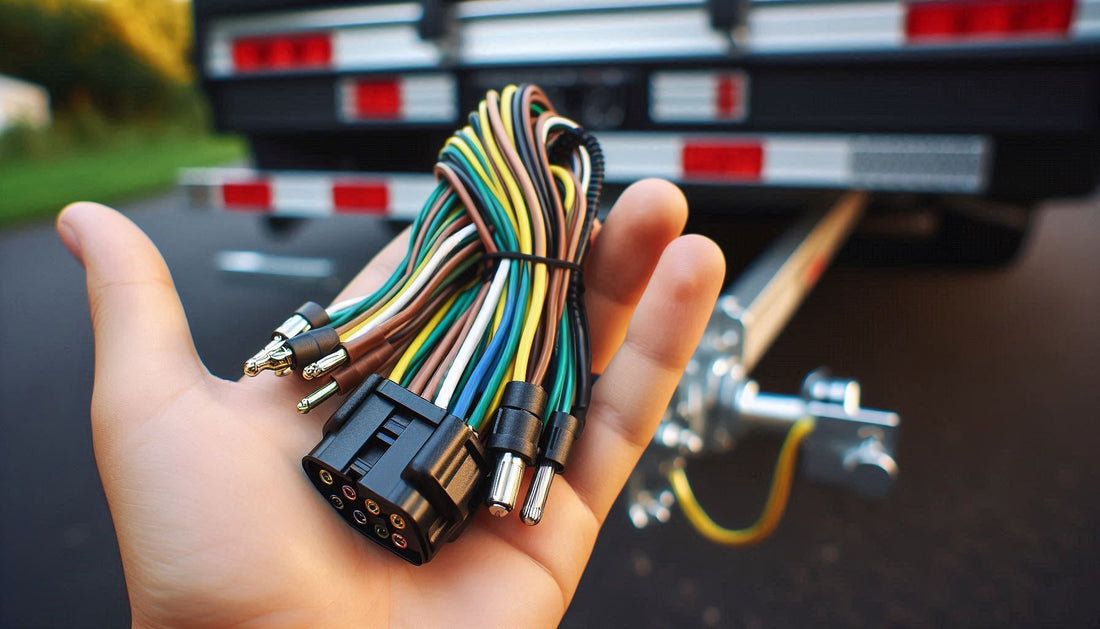
Understanding the Trailer Wiring Color Code: A Complete Guide
Share
Introduction
When it comes to towing a trailer safely, proper wiring is crucial. Each wire in a trailer's wiring harness serves a specific function, from controlling the brake lights to ensuring the turn signals flash at the right time. But understanding which wire goes where can be confusing if you don't know the color codes.
In this guide, we'll explain the standard trailer wiring color codes and what each wire does, so you can confidently wire your trailer for safe and legal towing.
Why Knowing Trailer Wiring Color Codes Is Important
If you want your trailer's lights, brakes, and other electrical systems to work properly, wiring it correctly is essential. A wrong connection can result in malfunctioning lights, which is not only dangerous but also illegal in many areas. By understanding the color code, you can ensure each wire is connected to its proper counterpart, leading to a safe and efficient towing experience.
The trailer wiring color code follows a standardized system in most cases, but it’s always a good idea to check your trailer's manual or consult with a professional if you’re unsure.

Common Trailer Wiring Color Codes and Their Functions
The wiring color codes for trailers typically follow a standardized system, especially for 4-way, 5-way, 6-way, and 7-way connectors. Below are the most common color codes and their functions:
| Wire Color | Wire Gauge | Function | Connector |
|---|---|---|---|
| White | 12 - 14 GA | Ground | All (4-way, 5-way, 6-way, 7-way) |
| Brown | 16 - 18 GA | Tail / Running Lights | All (4-way, 5-way, 6-way, 7-way) |
| Yellow | 16 - 18 GA | Left Turn Signal / Left Brake Light | All (4-way, 5-way, 6-way, 7-way) |
| Green | 16 - 18 GA | Right Turn Signal / Right Brake Light | All (4-way, 5-way, 6-way, 7-way) |
| Blue | 12 - 14 GA | Electric Brakes | 5-way, 6-way, 7-way |
| Red | 12 - 14 GA | Auxiliary Power or Reverse Lights | 6-way, 7-way |
| Black | 10 - 12 GA | Battery Charge / Auxiliary Power | 6-way, 7-way |
| Purple | 16 - 18 GA | Reverse Lights | 7-way |
Explanation of Recommended Wire Gauges:
- Ground and High-Power Functions (12 - 14 GA): Ground, electric brakes, auxiliary power, and battery charge require heavier gauge wires like 12 gauge - 14 gauge wires because they handle higher electrical loads.
- Lighting Functions (16 - 18 GA): Tail lights, turn signals, and running lights typically use 16 gauge to 18 gauge wires, as they carry lower currents.
- Battery and Power Functions (10 - 12 GA): For charging a trailer battery or powering larger appliances, such as on an RV, a thicker 10 gauge - 12 gauge wire is recommended to safely carry the required current.

Wiring Differences in 4-Way, 5-Way, 6-Way, and 7-Way Connectors
There are different types of connectors based on the number of functions your trailer needs. Here's a brief breakdown of each type:
4-Way Trailer Wiring
A 4-way connector is the most basic type of wiring and includes four wires that handle essential lighting functions. It is commonly used for smaller trailers.
- White: Ground
- Brown: Tail / Running lights
- Yellow: Left turn signal and brake light
- Green: Right turn signal and brake light
5-Way Trailer Wiring
The 5-way connector adds one additional wire for electric brakes or reverse lights.
- White: Ground
- Brown: Tail / Running lights
- Yellow: Left turn signal and brake light
- Green: Right turn signal and brake light
- Blue: Electric brakes or reverse lights
6-Way Trailer Wiring
The 6-way connector adds another wire for auxiliary power or battery charging, allowing for more advanced trailer functions.
- White: Ground
- Brown: Tail / Running lights
- Yellow: Left turn signal and brake light
- Green: Right turn signal and brake light
- Blue: Electric brakes
- Red / Black: Auxiliary power or reverse lights
7-Way Trailer Wiring
The 7-way connector is the most common for larger trailers and RVs, as it adds even more functionality, including power for reverse lights, battery charging, and electric brakes.
- White: Ground
- Brown: Tail / Running lights
- Yellow: Left turn signal and brake light
- Green: Right turn signal and brake light
- Blue: Electric brakes
- Red: Auxiliary power
- Black: Battery charge
- Purple: Reverse lights

Common Trailer Wiring Mistakes to Avoid
- Not Testing the System After Installation: Always test your wiring before hitting the road to ensure that everything is working properly.
- Using Incorrect Wire Gauge: Make sure you use the proper wire gauge for the electrical load. For instance, electric brakes typically require heavier wire than tail lights.
- Poor Ground Connection: A loose or corroded ground connection can lead to electrical issues. Ensure the ground wire is securely attached to clean, bare metal.
- Not Protecting the Wires: Trailer wiring is exposed to harsh conditions, so it’s important to use wire loom, heat shrink tubing, or other protective coverings to prevent damage from road debris, moisture, and corrosion.

Conclusion
Understanding the trailer wiring color code is key to ensuring your trailer’s lights and electrical systems work properly. Whether you’re wiring a simple 4-way connector or a more complex 7-way system, knowing which wire goes where will help you tow safely and legally. Always consult your trailer’s manual and follow wiring diagrams to avoid mistakes, and don’t forget to test your system before hitting the road. Properly wired trailers ensure safe journeys, whether you’re towing for work or pleasure. Additionally, using the correct wire gauge for each function will not only enhance performance but also prevent potential electrical failures. A well-maintained wiring system contributes to long-term reliability and peace of mind on the road.








